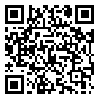1. Shafiei B, Mehralian Z. Nonfluency disorder in children. Isfahan: Isfahan University of Medical Sciences Pub. 2005. [Persian]
2. Howell P, Nilipour R. Stuttering. A clinical handbook on diagnosis assessment and treatment (in Farsi) [Internet]. Isfahan University Press; 2009. [Persian]
3. Bennett EM. Working with people who stutter: A lifespan approach. Prentice Hall; 2006.
4. Bloom C, Cooperman DK. Synergistic Stuttering Therapy: A Holistic Approach. Butterworth-Heinemann; 1999, pp: 296.
5. Yaruss JS, Quesal RW. Overall Assessment of the Speaker's Experience of Stuttering (OASES): Documenting multiple outcomes in stuttering treatment. Journal of fluency disorders. 2006; 31 (2): 90-115. [
DOI:10.1016/j.jfludis.2006.02.002]
6. Shafiei B, Salehi A, Karimi H, Yadegari F, Sima Shirazi T, Shafiei M. The validity and reliability of the Farsi version of" the overall assessment of the speaker's experience of stuttering-adult"(OASES-A) Questionnaire. J Res Rehabil Sci. 2012; 8 (1): 49-56. [Persian]
7. McDonough AN, Quesal RW. Locus of control orientation of stutterers and nonstutterers. Journal of Fluency Disorders. 1988; 13 (2): 97-106. [
DOI:10.1016/0094-730X(88)90031-9]
8. Johannisson TB, Wennerfeldt S, Havstam C, Naeslund M, Jacobson K, Lohmander A. The Communication Attitude Test (CAT-S): normative values for 220 Swedish children. International journal of language & communication disorders. 2009; 44 (6): 813-825. [
DOI:10.3109/13682820903201084]
9. Blood GW, Blood IM, Tellis G, Gabel R. Communication apprehension and self-perceived communication competence in adolescents who stutter. Journal of Fluency Disorders. 2001; 26 (3): 161-178. [
DOI:10.1016/S0094-730X(01)00097-3]
10. Gildston P. Stutterers' self-acceptance and perceived parental acceptance. Journal of abnormal psychology. 1967; 72 (1): 59. [
DOI:10.1037/h0024229]
11. Vanryckeghem M, Brutten GJ. A Comparative investigation of the BigCAT and Erickson S-24 measures of speech-associated attitude. Journal of Communication Disorders. 2012; 45 (5): 340-347. [
DOI:10.1016/j.jcomdis.2012.06.001]
12. Vanryckeghem M, Brutten GJ, Hernandez LM. A comparative investigation of the speech-associated attitude of preschool and kindergarten children who do and do not stutter. Journal of fluency disorders. 2005; 30 (4): 307-318. [
DOI:10.1016/j.jfludis.2005.09.003]
13. Riley GD. A stuttering severity instrument for children and adults. Journal of Speech and Hearing Disorders. 1972; 37 (3): 314-322. [
DOI:10.1044/jshd.3703.314]
14. Guitar B. Stuttering: An integrated approach to its nature and treatment [Internet]. Lippincott Williams & Wilkins; 2013
15. Brutten GJ, Vanryckeghem M. Behavior Assessment Battery for school-age children who stutter. Plural Publishing; 2007.
16. Cooper EB, De Nil LF. Is stuttering a speech disorder? Asha. 1999; 41 (2): 10.
17. Conture EG. Stuttering: Its Nature, Diagnosis, and Treatment. Allyn and Bacon; 2001, pp: 472.
18. Harris KS. The nature of stuttering (2nd Ed.). Van Riper Charles. Englwewood Cliffs, N.J.: Prentice-Hall, 1982. Pp. x 468. Applied Psycholinguistics. Cambridge University Press; 1983; 4 (2): 177-9. [
DOI:10.1017/S0142716400004458]
19. Andrews G, Cutler J. Stuttering therapy: The relation between changes in symptom level and attitudes. Journal of Speech & Hearing Disorders. 1974; 39 (3): 312-319. [
DOI:10.1044/jshd.3903.312]
20. Guitar B, Bass C. Stuttering therapy: the relation between attitude change and long-term outcome. J Speech Hear Disord. 1978; 43 (3): 392-400. [
DOI:10.1044/jshd.4303.392]
21. Vanryckeghem M, Brutten GJ. The BigCAT: A normative and comparative investigation of the communication attitude of nonstuttering and stuttering adults. Journal of Communication Disorders. 2011; 44 (2): 200-206. [
DOI:10.1016/j.jcomdis.2010.09.005]
22. Shultz KS, Whitney DJ, Zickar MJ. Measurement theory in action: Case studies and exercises [Internet]. Routledge; 2013. [
DOI:10.4324/9781315869834]
23. Tahmasbi Garmtani N, Farpour S, Modarres Zade SA, Hoseini Nasab SS, Moazeni A, Shafiei M. Stuttering Measurement Scale for Adults. [Isfahan]: Behta Pazhohesh; 2014. [Persian]
24. Bernardini S, Vanryckeghem M, Brutten GJ, Cocco L, Zmarich C. Communication attitude of Italian children who do and do not stutter. Journal of Communication Disorders. 2009; 42 (2): 155-161. [
DOI:10.1016/j.jcomdis.2008.10.003]
25. Brutten G, Vanryckeghem M. Behavior Assessment Battery: A multi-dimensional and evidence-based approach to diagnostic and therapeutic decision making for children who stutter. Belgium: Stichting Integratie Gehandicapten & Acco Publishers. 2003;
26. Vanryckeghem M, Brutten GJ. The speech-associated attitude of children who do and do not stutter and the differential effect of age. American Journal of Speech-Language Pathology. 1997; 6 (4): 67-73. [
DOI:10.1044/1058-0360.0604.67]
27. Vanryckeghem M, Brutten EJ. KiddyCat: Communication attitude test for preschool and kindergarten children who stutter. Plural Publishing Incorporated; 2007.

 ، فریبا یادگاری*1
، فریبا یادگاری*1 
 ، مارتین وان رایکهم2
، مارتین وان رایکهم2 

 ، سلمان عبدی3
، سلمان عبدی3 
 ، احسان شکاری4
، احسان شکاری4 
 ، سید صادق رحیمی1
، سید صادق رحیمی1 
 ، بهنام ترابیان بادی1
، بهنام ترابیان بادی1 





